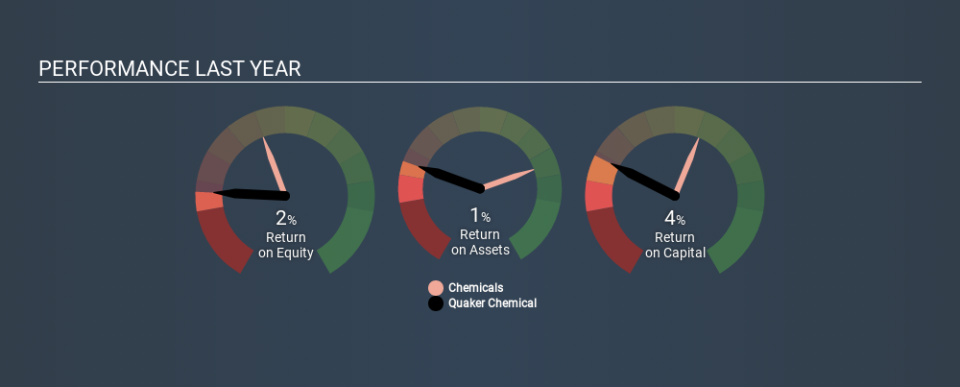Why You Should Care About Quaker Chemical Corporation’s (NYSE:KWR) Low Return On Capital

Today we are going to look at Quaker Chemical Corporation (NYSE:KWR) to see whether it might be an attractive investment prospect. To be precise, we'll consider its Return On Capital Employed (ROCE), as that will inform our view of the quality of the business.
First, we'll go over how we calculate ROCE. Next, we'll compare it to others in its industry. And finally, we'll look at how its current liabilities are impacting its ROCE.
Understanding Return On Capital Employed (ROCE)
ROCE measures the amount of pre-tax profits a company can generate from the capital employed in its business. In general, businesses with a higher ROCE are usually better quality. Ultimately, it is a useful but imperfect metric. Author Edwin Whiting says to be careful when comparing the ROCE of different businesses, since 'No two businesses are exactly alike.
How Do You Calculate Return On Capital Employed?
Analysts use this formula to calculate return on capital employed:
Return on Capital Employed = Earnings Before Interest and Tax (EBIT) ÷ (Total Assets - Current Liabilities)
Or for Quaker Chemical:
0.044 = US$105m ÷ (US$2.7b - US$346m) (Based on the trailing twelve months to September 2019.)
Therefore, Quaker Chemical has an ROCE of 4.4%.
View our latest analysis for Quaker Chemical
Does Quaker Chemical Have A Good ROCE?
One way to assess ROCE is to compare similar companies. We can see Quaker Chemical's ROCE is meaningfully below the Chemicals industry average of 10%. This could be seen as a negative, as it suggests some competitors may be employing their capital more efficiently. Putting aside Quaker Chemical's performance relative to its industry, its ROCE in absolute terms is poor - considering the risk of owning stocks compared to government bonds. There are potentially more appealing investments elsewhere.
Quaker Chemical's current ROCE of 4.4% is lower than 3 years ago, when the company reported a 15% ROCE. Therefore we wonder if the company is facing new headwinds. The image below shows how Quaker Chemical's ROCE compares to its industry, and you can click it to see more detail on its past growth.
Remember that this metric is backwards looking - it shows what has happened in the past, and does not accurately predict the future. ROCE can be deceptive for cyclical businesses, as returns can look incredible in boom times, and terribly low in downturns. ROCE is, after all, simply a snap shot of a single year. What happens in the future is pretty important for investors, so we have prepared a free report on analyst forecasts for Quaker Chemical.
Quaker Chemical's Current Liabilities And Their Impact On Its ROCE
Current liabilities are short term bills and invoices that need to be paid in 12 months or less. The ROCE equation subtracts current liabilities from capital employed, so a company with a lot of current liabilities appears to have less capital employed, and a higher ROCE than otherwise. To counter this, investors can check if a company has high current liabilities relative to total assets.
Quaker Chemical has total liabilities of US$346m and total assets of US$2.7b. As a result, its current liabilities are equal to approximately 13% of its total assets. This is a modest level of current liabilities, which will have a limited impact on the ROCE.
Our Take On Quaker Chemical's ROCE
That's not a bad thing, however Quaker Chemical has a weak ROCE and may not be an attractive investment. Of course, you might find a fantastic investment by looking at a few good candidates. So take a peek at this free list of companies with modest (or no) debt, trading on a P/E below 20.
If you are like me, then you will not want to miss this free list of growing companies that insiders are buying.
If you spot an error that warrants correction, please contact the editor at editorial-team@simplywallst.com. This article by Simply Wall St is general in nature. It does not constitute a recommendation to buy or sell any stock, and does not take account of your objectives, or your financial situation. Simply Wall St has no position in the stocks mentioned.
We aim to bring you long-term focused research analysis driven by fundamental data. Note that our analysis may not factor in the latest price-sensitive company announcements or qualitative material. Thank you for reading.

 Yahoo Finance
Yahoo Finance 
